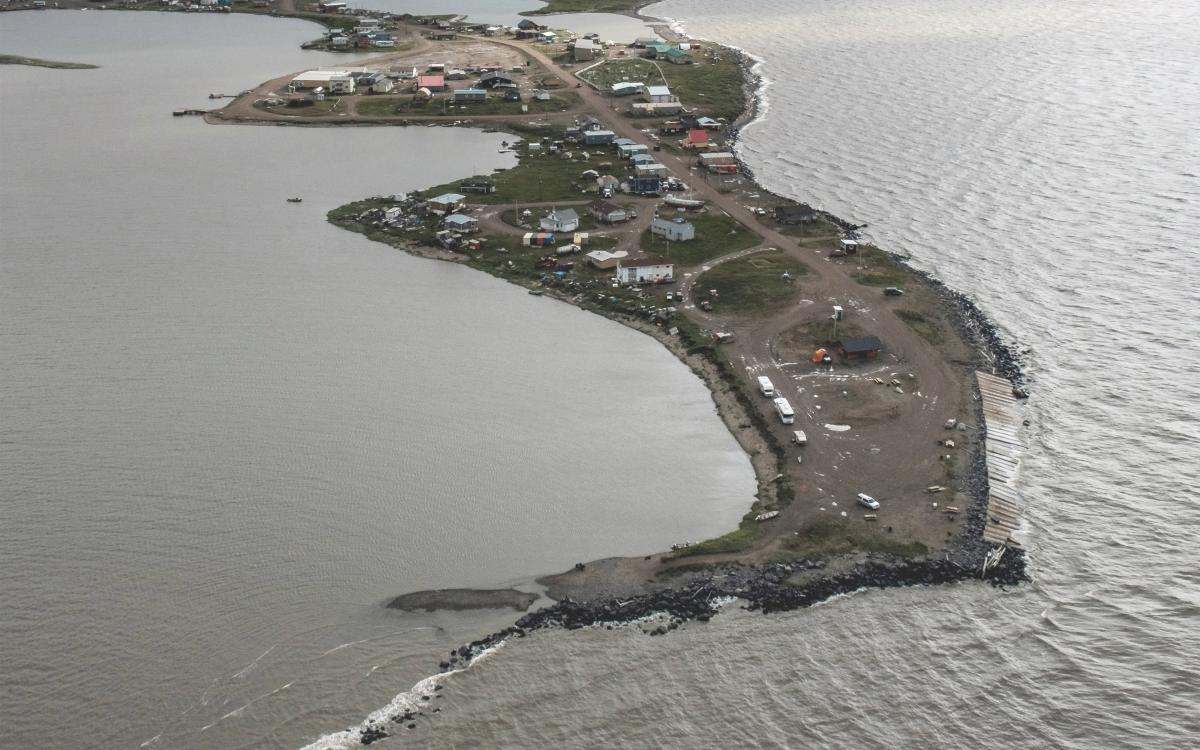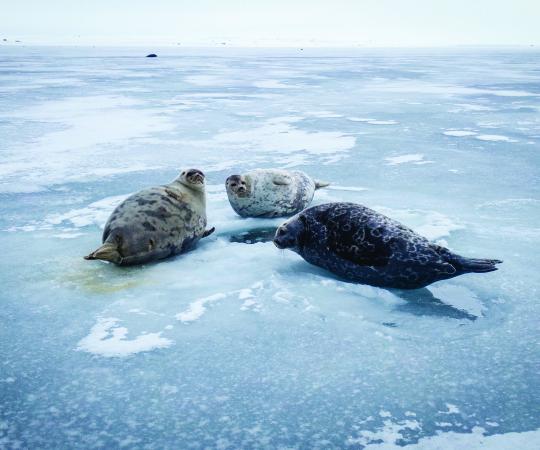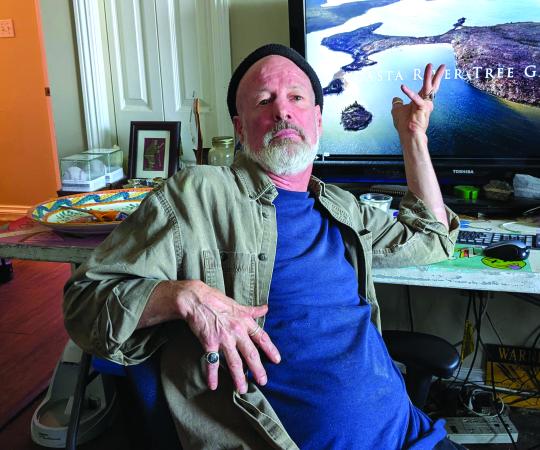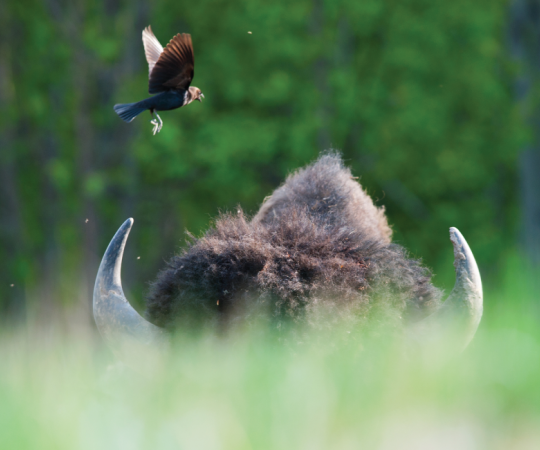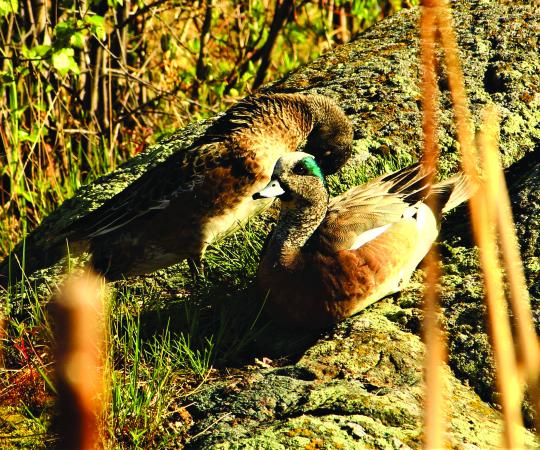Sandy Adam barely recognizes his backyard these days. The Arctic Ocean has taken most of it away. “Too much,” he says, shaking his head. “Way too much.”
Sandy and Sarah Adam are two of the few remaining residents of the Point, a small and shrinking peninsula at the end of scenic Beaufort Drive in Tuktoyaktuk, NWT. The couple’s home buzzes with activity. Sarah sorts and bags cloudberries she and some family members picked along the Inuvik to Tuktoyaktuk highway. Loaves of fresh bread are stacked on the kitchen table. In all, 11 family members—including six grandchildren—live here.
Sarah used to let their dogs run all over the backyard. She points out the living room window—all you can see is the Arctic Ocean. Gone is the beach that ran along the coast in 1994, when they first moved in. You have to press your nose against the windowpane and look straight down to see land. There’s no backyard to speak of.
Sandy, Sarah and their neighbours are now faced with one option: literally lifting their homes and hauling them to safer spots inland. The Adams began relocation planning in 2014 and hoped this would be their last summer at the Point. But before their house can be moved, it needs to be assessed by an engineer to determine whether it can structurally withstand the relocation. And the house’s new home still needs work: the house will sit on a gravel pad to keep the permafrost below from thawing and shifting, but that pad needs to settle for a year before any structure can be placed on top of it.
Residents of the Point are being offered lots by the hamlet at Reindeer Point, roughly seven kilometres away, but nobody seems eager to move there. For one, it’s far from the community’s core—too far for an elder to walk. Sandy would prefer to move his home across Beaufort Drive to where his father’s log house used to stand, in a more sheltered area of the peninsula. But hamlet authorities won’t allow it. Even though the lot is roughly 50 metres from shore, it is still technically on the Point and no new development is permitted because of the quickly progressing erosion.
Shore erosion is nothing new in Tuktoyaktuk, an Inuvialuit community of 900, east of the Mackenzie River delta. What is new is the pace at which it’s happening. When the Adams moved into their home nearly 25 years ago, they say it wasn’t a concern.
“We can do everything in our power to protect the town, but there is one thing we can’t prevent: climate change."
The Arctic is warming up roughly twice as fast as the rest of the planet. Thawing permafrost, a shorter sea ice season, more severe storms, and rising seas are contributing to an increased rate of erosion along the Arctic coast. The ground below Tuktoyaktuk is a mixture of gravel, sand and silt, capped by a thin organic layer. Below that are fine-grained deltaic sands and ice contained within a permafrost layer. As this permafrost and ice thaws, it heaves and the ground collapses.
Tuktoyaktuk’s harbour is the nucleus around which the community was built. It’s the only Canadian seaport on the Beaufort Sea and is well protected by Tuktoyaktuk Island, a spit of land one-kilometre in length with a handful of smokehouses dotting its sandy shore. Unfortunately, the island is also slowly washing away: it may be breached within the next 30 years.
With the assistance of scientists from the Geological Survey of Canada, the hamlet is contemplating the possibility of placing an artificial barrier on the windward side of the island to protect it. Introducing artificial barriers has been a common and effective strategy in many coastal communities all over the world, says Dustin Whalen, a scientist with Natural Resources Canada, who has been conducting coastal research in the area for the last 15 years.
But building them on permafrost presents a whole new set of challenges because that coastline is not only eroding from the constant battering of the ocean, but thawing too. Over the last few decades, the community has tried, with moderate success, to slow the erosion by reinforcing the most exposed sections of shoreline along the residential area with “rip-rap” (breakwaters made of boulders), geotextile (a fabric that covers the shore to help it maintain its integrity), and concrete pads.
Tuktoyaktuk is far from the only site along the Arctic coast that’s affected. Pelly Island, located 100 kilometres to the northwest, is believed to be one of the most rapidly eroding islands in the world. With an erosion rate of up to 30 metres per year, the uninhabited island is washing away nearly 10 times faster than the windward shore in Tuktoyaktuk. Scientists study erosion on Pelly Island every summer to better understand the mechanisms associated with the process along the Arctic coast, which may help communities like Tuktoyaktuk to improve protections or make more informed decisions on future developments or relocation plans.
Lucy Cockney, another resident of the Point facing relocation, hopes new boulders added to the rip-rap behind her house can buy her a few more years. She worries her two-storey home will be damaged during the move over Tuktoyaktuk’s bumpy roads, and she won’t be able to afford costly repairs.
When the hamlet received funding to relocate the privately owned houses from the Point, it didn’t include insurance covering damages. Cockney says there’s still no gravel pad at the lot she hopes to move to. Nobody, she says, seems to know what is going on with the relocation process. Her daughter Noella lives next door and she will also eventually need to move further inland. Her father built her house and she doesn’t know what she will do if her home is deemed unmovable.
As residents build reinforcements for now, they wonder how long this strategy will remain viable if the land literally disappears under their feet. Will the entire community eventually be relocated, as has been proposed for communities on the north coast of Alaska? It’s a controversial and divisive issue in town. Some are dead-set against any kind of relocation.
But Tuktoyaktuk Mayor Merven Gruben says the gradual process of moving inland has already begun. “Like it or not, it’s a reality we are living with already,” he says, citing the development in Reindeer Point and the building ban in the areas threatened by erosion. Gruben believes it will be a slow transition over many years.
Although Northern communities are some of the first to feel the severe effects of global warming, there is very little they can actually do to slow it down. The hamlet is looking into alternative sources of energy to cut down on fossil fuel consumption, but Gruben calls that a drop in the ocean. “We can do everything in our power to protect the town, but there is one thing we can’t prevent: climate change. All we can do is to educate the public down south to care for the environment.”

